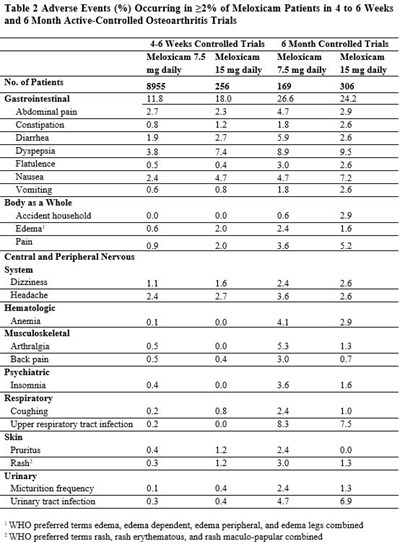Product Images Meloxicam
View Photos of Packaging, Labels & Appearance
Product Label Images
The following 15 images provide visual information about the product associated with Meloxicam NDC 71610-881 by Aphena Pharma Solutions - Tennessee, Llc, such as packaging, labeling, and the appearance of the drug itself. This resource could be helpful for medical professionals, pharmacists, and patients seeking to verify medication information and ensure they have the correct product.
MG1 - MG1

This text provides important information about the potential risks associated with the use of NSAIDs (Nonsteroidal Anti-inflammatory Drugs). It advises caution when taking NSAIDs with increasing doses or for extended periods. Moreover, it highlights specific scenarios where NSAIDs should be avoided, such as before or after heart surgery (CABG) and after a recent heart attack due to the increased risk of further heart complications. It emphasizes the importance of consulting with a healthcare provider before using NSAIDs in these situations.*
MG2 - MG2

This text provides important information about the potential risks associated with the use of NSAIDs (Nonsteroidal anti-inflammatory drugs). It warns about the increased risk of developing ulcers or bleeding, especially for individuals with a history of stomach ulcers, those taking certain medications like corticosteroids or anticoagulants, increasing the dosage or duration of NSAID use, smoking, consuming alcohol, being of older age, having poor health, advanced liver disease, or bleeding problems. These risk factors should be considered in order to avoid severe complications.*
MG4 - MG4
This text appears to be describing potential symptoms of a medical condition. It includes shortness of breath or trouble breathing, slurred speech, chest pain, swelling of the face or throat, and weakness in one part or side of your body. These symptoms may indicate a serious health issue and should be evaluated by a medical professional.*
MG5 - MG5

This text provides a list of symptoms that may indicate a serious health issue. These symptoms include nausea, fatigue, diarrhea, itching, yellowing of the skin or eyes, stomach pain, flu-like symptoms, vomiting blood, presence of blood in bowel movements, unexplained weight gain, skin rash with fever, and swelling in arms, legs, hands, and feet. If experiencing any of these symptoms, it is advisable to seek medical attention promptly.*
table 1a - table 1a

This is a table presenting the adverse events (%) occurring in 22% of Meloxicam patients during an osteoarthritis placebo- and active-controlled trial. The table includes data on various adverse events such as gastrointestinal issues, abdominal pain, diarrhea, accidents, edema, falls, flu-like symptoms, dizziness, headaches, respiratory issues, and skin problems. The table compares the occurrence of these adverse events among patients taking Placebo, Meloxicam (15mg daily), Meloxicam (100mg daily), and Diclofenac.*
table 1b - table 1b

This text provides a table showing the adverse events occurring in more than 2% of Meloxicam patients in two 12-week Rheumatoid Arthritis Placebo-Controlled Trials. It includes the number of patients, types of disorders such as gastrointestinal disorders, musculoskeletal disorders, nervous system disorders, skin and subcutaneous issues, and various symptoms experienced by patients such as abdominal pain, dyspeptic signs, nausea, headaches, and rash. Specific preferred terms in the MedDRA (Medical Dictionary for Regulatory Activities) are identified for some symptoms. The table gives an insight into the common adverse events associated with Meloxicam use in patients with Rheumatoid Arthritis.*
table 2.1 - table 2.1

This is a list of potential side effects and symptoms that may occur in various parts of the body when taking a specific medication. It includes a wide range of effects such as allergic reactions, cardiovascular issues, nervous system disturbances, gastrointestinal problems, changes in heart rate and rhythm, hematologic issues, liver and biliary system effects, metabolic changes, psychiatric symptoms, respiratory problems, skin and appendage issues, special senses disturbances, and urinary system complications. It serves as a useful reference for healthcare providers and patients to be aware of the possible adverse reactions that may arise during treatment.*
table 2 - table 2

This is a table presenting adverse events (%) occurring in more than 2% of Meloxicam patients during 4 to 6-week and 6-month active-controlled osteoarthritis trials. The table displays different side effects based on the dosage of Meloxicam (7.5mg daily, 15mg daily, and 1Smedaily). Adverse events such as gastrointestinal issues, abdominal pain, constipation, diarrhea, dyspepsia, nausea, vomiting, edema, headache, musculoskeletal pain, insomnia, respiratory conditions, skin issues, and urinary tract infections are documented. Additionally, WHO preferred terms for edema and rash are combined to provide a comprehensive overview of the reported adverse effects.*
table 3.1 - table 3.1

This text provides important information on potential drug interactions involving Meloxicam, a nonsteroidal anti-inflammatory drug (NSAID). It discusses the clinical impacts and interventions needed when Meloxicam is used concomitantly with lithium, methotrexate, cyclosporine, other NSAIDs or salicylates, and pemetrexed. Monitoring for signs of toxicity, especially regarding renal function and GI issues, is emphasized. Dosing adjustments and recommendations for patients with renal impairment are also highlighted. These details are crucial for healthcare providers to ensure patient safety and optimize treatment outcomes when prescribing Meloxicam in combination with other medications.*
table 3 - table 3

Table 3 highlights clinically significant drug interactions with Meloxicam, focusing on potential interactions with drugs affecting hemostasis, such as anticoagulants and antiplatelet agents. The use of Meloxicam with such medications can increase the risk of serious bleeding. Additionally, there is a caution against the concomitant use of Meloxicam and low-dose aspirin due to the elevated risk of bleeding and GI adverse reactions. Monitoring for bleeding signs is recommended with the concurrent use of Meloxicam with various medications, including ACE inhibitors, NSAIDs, and diuretics. The text emphasizes the importance of monitoring blood pressure, renal function, and overall clinical effects when combining Meloxicam with these drug classes.*
* The product label images have been analyzed using a combination of traditional computing and machine learning techniques. It should be noted that the descriptions provided may not be entirely accurate as they are experimental in nature. Use the information in this page at your own discretion and risk.



